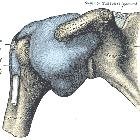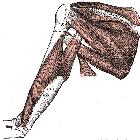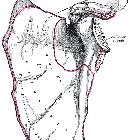Shoulder radiograph (an approach)





Shoulder radiographs are common films to see in the Emergency Department, especially during the weekend after sporting events.
Systematic review
Choosing a search strategy and utilizing it consistently is a helpful method to overcome common errors seen in diagnostic radiology. The order in which you interpret the radiograph is personal preference. A recommended systematic checklist for reviewing musculoskeletal exams is: soft tissue areas, cortical margins, trabecular patterns,bony alignment, joint congruency, and review areas. Review the entire radiograph,regardless of perceived difficulty. Upon identifying an abnormality, do not cease the review, put it to the side and ensure to complete the checklist.
Soft tissue
Assess all soft tissue structure for any associated or incidental soft tissue signs
Bony cortex
- cortex should be smooth
- humeral head
- glenoid fossa
- clavicle
- body of scapula
- look for fracture fragments
- remember the ribs
Joints and alignment
Glenohumeral joint
- articular surfaces should be parallel
- the humeral head should be on the glenoid in any other view
- if the humeral head lies under the coracoid process, think anterior shoulder dislocation
- if there is a joint effusion, think humeral head or glenoid fracture
Acromioclavicular joint
- the inferior borders of distal clavicle and acromion should line up
- if there is a step, think ACJ injury
- acromioclavicular (AC) distance >8 mm: AC ligament rupture
- coracoclavicular (CC) distance >13 mm: CC ligament rupture
Review areas
Although a majority of your focus may be on the shoulder girdle, be vigilant in inspecting the entire radiograph including the:
- ribs
- lung (e.g. pneumothorax, Pancoast tumor)
- any bony/soft tissue regions included in the projection
Common pathology
Anterior shoulder dislocation
- 95% of all shoulder dislocations
- young males and the elderly
- forced abduction, external rotation and extension
- humeral head lies anterior, medial and inferior to glenoid fossa
- common associated fractures
- more: anterior shoulder dislocation
Clavicle fracture
- up to 10% of all fractures
- predominantly midshaft
- mostly children and the elderly
- fall onto outstretched hand or shoulder
- more: clavicle fracture
Acromioclavicular joint injury
- very common injury
- range from strain to complete joint disruption
- direct blow or fall onto shoulder with adducted arm
- step at AC joint, widening of AC joint and/or increased CC distance
- more: acromioclavicular joint injury
Proximal humeral fracture
- common injury resulting in significant disability
- elderly females: mean age 65 years
- fall on an outstretched arm
- more: proximal humeral fracture
Don't miss
Posterior shoulder dislocation
- less than 5% of glenohumeral dislocations but often overlooked
- common in adults following a seizure or in the elderly
- humeral head forced posteriorly in internal rotation whilst arm is abducted
- classically, the humeral head is rounded on AP - light bulb sign
- associated with anteromedial fracture of humeral head
- more: posterior shoulder dislocation
Shoulder pseudosubluxation
- usually secondary to trauma
- an effusion or hemorrhage into the joint displaces the humeral head inferiorly
- this effusion suggests intra-articular fracture
- do not confuse with dislocation!
- more: shoulder pseudosubluxation
Pancoast tumor
- primary bronchogenic carcinoma arising in lung apex
- account for up to 5% of all bronchogenic cancers
- always review lung parenchyma, ribs and supraclavicular fossa in AP shoulder radiographs
- more: Pancoast tumor
Related Radiopaedia articles
Approaches to radiographs
- adult
- head, neck and spine
- skull radiograph
- facial radiographs
- cervical spine radiograph
- thoracolumbar spine radiograph
- upper limb
- chest
- frontal
- lateral
- decubitus
- abdomen
- lower limb
- head, neck and spine
- child
- head, neck and spine
- skull radiograph
- facial radiographs
- cervical spine radiograph
- thoracolumbar spine radiograph
- upper limb
- shoulder radiograph
- elbow radiograph
- wrist radiograph
- hand radiograph
- chest
- abdomen
- lower limb
- pelvic radiograph
- knee radiograph
- ankle radiograph
- foot radiograph
- head, neck and spine
Imaging the shoulder
- imaging the shoulder
- plain film
- scapula x-ray series
- shoulder x-ray series
- acromioclavicular joint x-ray series
- clavicle x-ray series
- sternoclavicular joint x-ray series
- ultrasound shoulder
- CT shoulder
- MRI shoulder
- plain film
Siehe auch:
- Buford-Komplex
- sublabrales Foramen
- sublabraler Recessus
- Musculus teres minor
- Musculus infraspinatus
- Ligamentum coracoclaviculare
- Schultermuskulatur
- Musculus subscapularis
- Musculus supraspinatus
- Glenohumerale Bänder
- Articulatio acromioclavicularis
- labral variants
- Ursprung lange Bizepssehne
- Musculus biceps brachii, Caput longum
- kurze Bizepssehne
und weiter:

 Assoziationen und Differentialdiagnosen zu Shoulder XR:
Assoziationen und Differentialdiagnosen zu Shoulder XR:









